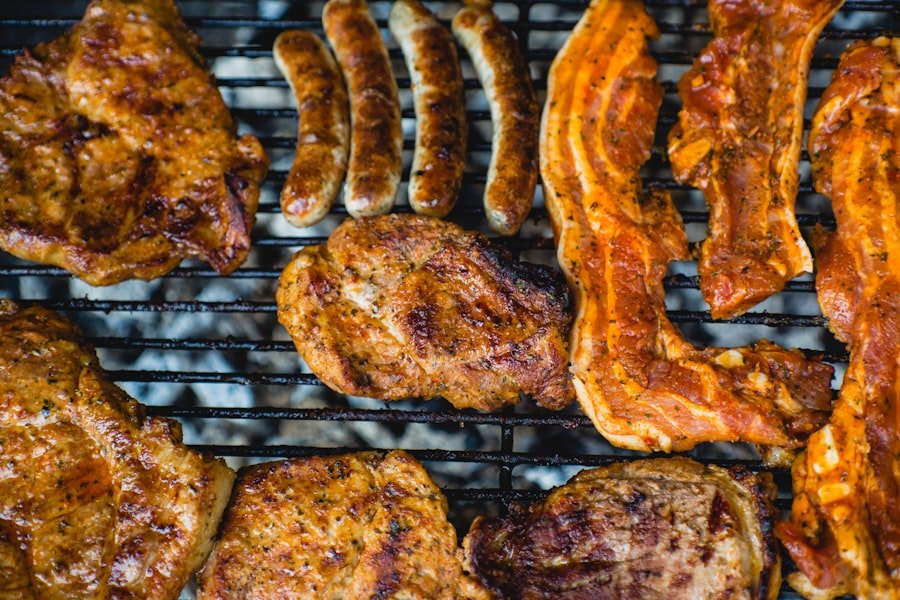Brisket is a cut of meat from the lower chest of cattle with a long history in various cultures worldwide. In the United States, it gained popularity in the southern states, particularly Texas, where it became a central part of barbecue culture. The slow-cooking method for brisket is believed to have originated with Jewish immigrants from Central Europe who brought their traditional cooking techniques to America.
Brisket plays a significant role in multiple cuisines. In Jewish tradition, it is often braised and served during holidays and special occasions. Asian cuisines incorporate brisket into soups and stews, prizing it for its rich flavor and tender texture.
The cut has gained prominence in the culinary world, with chefs exploring new cooking techniques and flavor combinations. The versatility of brisket has contributed to its enduring popularity. It is commonly featured at backyard barbecues, family gatherings, and special events in the United States.
Different regions have developed their own styles and techniques for preparing and grilling brisket, further enriching its culinary heritage. In recent years, brisket has become a subject of culinary innovation, with chefs creating unique and experimental dishes. This ongoing evolution in preparation methods and flavor profiles demonstrates the continued relevance and appeal of brisket in contemporary cuisine.
Key Takeaways
- Brisket has a long history, dating back to the 15th century when it was a popular cut of meat in Europe.
- When choosing the right cut of brisket, look for a well-marbled piece with a good balance of fat and meat.
- Preparing and seasoning the brisket involves trimming excess fat, applying a dry rub or marinade, and allowing it to sit for several hours or overnight.
- Grilling techniques for perfect brisket include using indirect heat, maintaining a consistent temperature, and using wood chips for added flavor.
- Tips for maintaining moisture and flavor include wrapping the brisket in foil during the cooking process and allowing it to rest before slicing.
- When slicing and serving the brisket, be sure to cut against the grain for maximum tenderness and serve with your favorite sides and sauces.
- Pairing sides and sauces with grilled brisket can include classic options like coleslaw, mac and cheese, and barbecue sauce, as well as more unique options like pickled vegetables and chimichurri.
Choosing the Right Cut of Brisket
Understanding the Two Main Cuts of Brisket
There are two main cuts of brisket: the flat cut (also known as the “first cut”) and the point cut (also known as the “second cut” or “deckle”). The flat cut is leaner and has less fat marbling, making it a popular choice for those who prefer a leaner brisket.
Factors to Consider When Selecting a Brisket
On the other hand, the point cut has more fat marbling, which gives it a richer flavor and juicier texture. When selecting a brisket for grilling, it’s important to consider the level of marbling and fat content, as well as the size and thickness of the cut. Another factor to consider when choosing a brisket is whether it is bone-in or boneless.
Choosing the Right Brisket for a Delicious Grilled Dish
While bone-in brisket can add flavor and moisture to the meat during grilling, boneless brisket is often easier to slice and serve. Additionally, it’s important to look for a brisket that has a good amount of thickness and uniformity, as this will ensure even cooking and consistent results. Whether you prefer the leaner flat cut or the more flavorful point cut, selecting the right brisket is essential for creating a delicious and tender grilled dish that will impress your guests and leave them coming back for more.
Preparing and Seasoning the Brisket

Before grilling a brisket, it’s important to properly prepare and season the meat to enhance its flavor and tenderness. One popular method for preparing brisket is to trim any excess fat from the surface of the meat, as this can help prevent flare-ups during grilling and allow the seasonings to better penetrate the meat. However, it’s important to leave a thin layer of fat on one side of the brisket to help keep it moist and flavorful during cooking.
Additionally, scoring the fat cap with a sharp knife can help the seasonings penetrate the meat and create a delicious crust during grilling. When it comes to seasoning a brisket, there are countless options for creating a flavorful rub or marinade. A classic Texas-style rub often includes a combination of salt, black pepper, garlic powder, onion powder, paprika, and other spices for a savory and slightly spicy flavor profile.
For those who prefer a sweeter and smokier taste, a Kansas City-style rub may include brown sugar, smoked paprika, cumin, and other aromatic spices. Regardless of the seasoning blend you choose, it’s important to generously coat the brisket with the rub or marinade and allow it to sit for at least an hour (or preferably overnight) to allow the flavors to fully infuse into the meat. Properly preparing and seasoning the brisket is an essential step in creating a mouthwatering grilled dish that will delight your taste buds and leave you craving more.
Grilling Techniques for Perfect Brisket
| Grilling Technique | Description |
|---|---|
| Low and Slow | Cook the brisket at a low temperature (225-250°F) for a long period of time to ensure tenderness. |
| Indirect Heat | Cook the brisket using indirect heat to prevent burning and to allow for even cooking. |
| Wood Smoke | Use wood chips or chunks to add a smoky flavor to the brisket while grilling. |
| Resting Period | Allow the brisket to rest for at least 30 minutes after grilling to retain juices and tenderness. |
Grilling brisket requires patience, skill, and attention to detail to achieve perfect results. One popular method for grilling brisket is using a smoker or charcoal grill with indirect heat, which allows for slow cooking at low temperatures to tenderize the meat and infuse it with smoky flavor. When using a smoker, it’s important to maintain a consistent temperature between 225-250°F (107-121°C) throughout the cooking process to ensure even cooking and optimal tenderness.
Additionally, adding wood chips or chunks to the coals can create a flavorful smoke that will enhance the taste of the brisket. Another grilling technique for perfect brisket is the “Texas crutch,” which involves wrapping the brisket in foil or butcher paper during the cooking process to help retain moisture and speed up the cooking time. This method can help prevent the brisket from drying out while still allowing it to absorb smoke and develop a delicious bark on the exterior.
However, it’s important to monitor the internal temperature of the brisket using a meat thermometer to ensure it reaches an ideal temperature of 195-205°F (90-96°C) for optimal tenderness. In addition to using indirect heat and the Texas crutch method, basting the brisket with a flavorful mop sauce or spritzing it with apple cider vinegar can help keep it moist and add layers of flavor during grilling. Whether you prefer using a smoker or charcoal grill, mastering these grilling techniques is essential for creating a perfectly cooked brisket that is tender, juicy, and bursting with smoky goodness.
Tips for Maintaining Moisture and Flavor
Maintaining moisture and flavor is key to achieving a delicious and tender grilled brisket. One important tip for keeping brisket moist during grilling is to use a water pan or drip pan filled with liquid (such as water, apple juice, or beer) to create steam and humidity inside the grill or smoker. This can help prevent the meat from drying out and add an extra layer of moisture to enhance its tenderness.
Another tip for maintaining moisture and flavor is to periodically check on the brisket during grilling and rotate it as needed to ensure even cooking. This can help prevent hot spots or uneven browning on the meat and allow it to cook consistently throughout. Additionally, using a meat thermometer to monitor the internal temperature of the brisket can help prevent overcooking or undercooking, ensuring that it reaches the ideal temperature for optimal tenderness.
Furthermore, allowing the brisket to rest for at least 30 minutes after grilling can help redistribute its juices and lock in moisture before slicing and serving. This resting period allows the meat to relax and become more tender, resulting in a juicier and more flavorful final dish. By following these tips for maintaining moisture and flavor, you can ensure that your grilled brisket turns out perfectly succulent and bursting with delicious taste.
Slicing and Serving the Brisket

Pairing Sides and Sauces with Grilled Brisket
Pairing sides and sauces with grilled brisket can elevate its flavors and create a well-rounded dining experience. When it comes to sides, classic barbecue accompaniments such as coleslaw, potato salad, baked beans, macaroni and cheese, or cornbread are popular choices that complement the rich and savory taste of brisket. These sides provide a balance of textures and flavors that enhance the overall meal and create a satisfying dining experience.
In addition to sides, choosing the right sauce can enhance the flavor of grilled brisket and add an extra layer of deliciousness. Traditional barbecue sauces such as Kansas City-style (sweet and tangy), Texas-style (spicy and bold), or Carolina-style (vinegar-based) are popular options that pair well with grilled brisket. These sauces can be served on the side for dipping or drizzled over sliced brisket for added moisture and flavor.
For those who prefer a lighter accompaniment, serving grilled brisket with fresh salads or grilled vegetables can provide a refreshing contrast to its rich taste. Whether you choose classic barbecue sides, flavorful sauces, or lighter accompaniments, pairing sides and sauces with grilled brisket is an opportunity to create a well-balanced meal that will satisfy your cravings and leave you feeling fully satisfied. In conclusion, grilling brisket is an art form that requires patience, skill, and attention to detail.
From selecting the right cut of meat to preparing, seasoning, grilling, slicing, serving, and pairing sides with this delectable dish, each step plays a crucial role in creating a mouthwatering culinary experience that will delight your taste buds and leave you craving more. Whether you’re hosting a backyard barbecue or simply craving some delicious comfort food, mastering these techniques for grilling perfect brisket will elevate your culinary skills and impress your guests with an unforgettable dining experience.
If you’re looking for more grilling tips and recipes, be sure to check out the article on Grilloffers.com. They offer a wide range of resources for grill enthusiasts, including how to cook brisket on the grill. Whether you’re a beginner or a seasoned pro, their website has everything you need to elevate your grilling game. Check out their website for more information.

